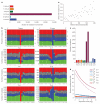A comprehensive catalogue of somatic mutations from a human cancer genome
- PMID: 20016485
- PMCID: PMC3145108
- DOI: 10.1038/nature08658
A comprehensive catalogue of somatic mutations from a human cancer genome
Abstract
All cancers carry somatic mutations. A subset of these somatic alterations, termed driver mutations, confer selective growth advantage and are implicated in cancer development, whereas the remainder are passengers. Here we have sequenced the genomes of a malignant melanoma and a lymphoblastoid cell line from the same person, providing the first comprehensive catalogue of somatic mutations from an individual cancer. The catalogue provides remarkable insights into the forces that have shaped this cancer genome. The dominant mutational signature reflects DNA damage due to ultraviolet light exposure, a known risk factor for malignant melanoma, whereas the uneven distribution of mutations across the genome, with a lower prevalence in gene footprints, indicates that DNA repair has been preferentially deployed towards transcribed regions. The results illustrate the power of a cancer genome sequence to reveal traces of the DNA damage, repair, mutation and selection processes that were operative years before the cancer became symptomatic.
Figures


References
-
- Futreal PA, et al. Cancer and genomics. Nature. 2001;409:850–852. - PubMed
Publication types
MeSH terms
Substances
Grants and funding
LinkOut - more resources
Full Text Sources
Other Literature Sources
Molecular Biology Databases
Research Materials

